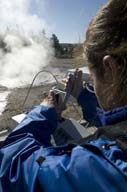 (ARTEL: Westbrook, Maine) -- Data taken at Yellowstone National Park during Mission No. 2 of the ARTEL Extreme Pipetting Expedition show that pipettes deliver volumes inaccurate by up to 37 percent when handling fluids at temperatures different from the pipettes. Called thermal disequilibrium (TD), this source of error is prevalent in today’s laboratories, as many assays and tests require the addition of liquids which are warmer or colder than the laboratory environment and the actual pipettes. Yellowstone was selected for Mission No. 2 of the expedition because it’s emblematic of thermal variation and disequilibrium. The extreme pipetting expedition is a multi-phase, year-long scientific study to investigate and illustrate the impact of laboratory conditions on data integrity.
(ARTEL: Westbrook, Maine) -- Data taken at Yellowstone National Park during Mission No. 2 of the ARTEL Extreme Pipetting Expedition show that pipettes deliver volumes inaccurate by up to 37 percent when handling fluids at temperatures different from the pipettes. Called thermal disequilibrium (TD), this source of error is prevalent in today’s laboratories, as many assays and tests require the addition of liquids which are warmer or colder than the laboratory environment and the actual pipettes. Yellowstone was selected for Mission No. 2 of the expedition because it’s emblematic of thermal variation and disequilibrium. The extreme pipetting expedition is a multi-phase, year-long scientific study to investigate and illustrate the impact of laboratory conditions on data integrity.
…
Add new comment